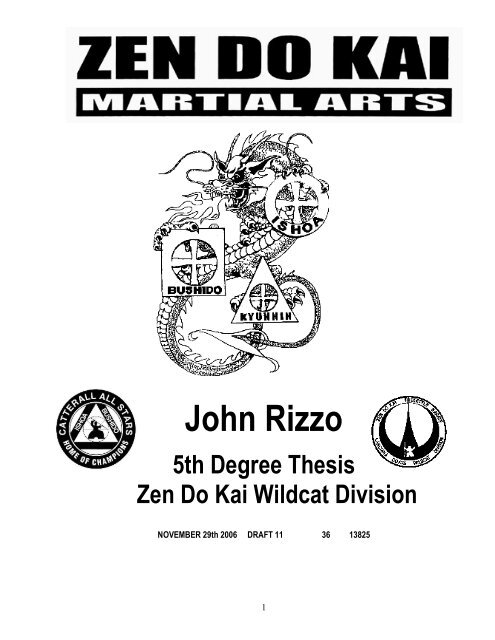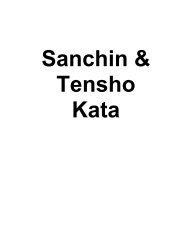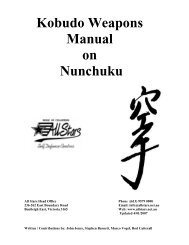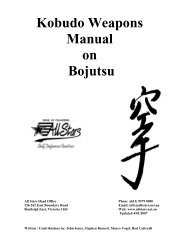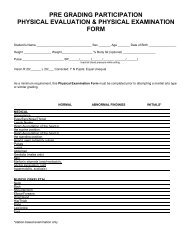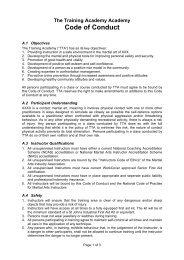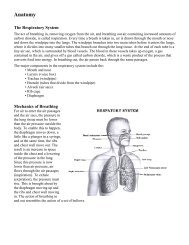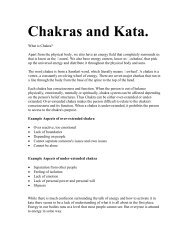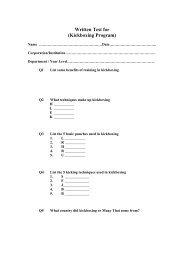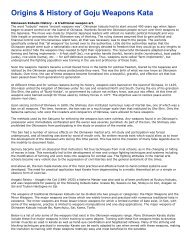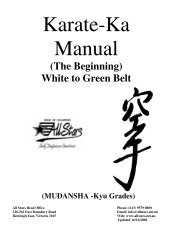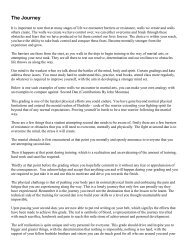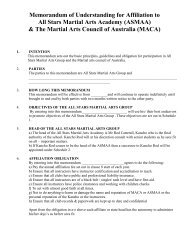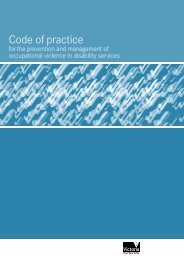John Rizzo - All Stars Self Defence Centres
John Rizzo - All Stars Self Defence Centres
John Rizzo - All Stars Self Defence Centres
- No tags were found...
Create successful ePaper yourself
Turn your PDF publications into a flip-book with our unique Google optimized e-Paper software.
<strong>John</strong> <strong>Rizzo</strong>5th Degree ThesisZen Do Kai Wildcat DivisionNOVEMBER 29th 2006 DRAFT 11 36 138251
5 th Dan Thesis Layout• Front page• 5 th Dan Thesis Layout• Purpose of Thesis• Personal Profile• What is Karate• The History Of Karate• Zen Do Kai Lineage• What is Kata• History of Kata• The Seven Aspects of Kata• What are the purposes & benefits of Kata to a karateka• What tools facilitate Kata - Patrick McCarthy• Zen Do Kai Katas2
Purpose of ThesisAs part of the development, understanding and progression from 4 th Degree to 5 th Degree,Kyoshi Steve Nedelkos, has requested that I express and document my thoughts on a martialarts related subject at this stage of my training life.The subject choice & content are a combination of my personal thoughts as well as research &input via external sources (eg: books, videos, internet, etc).I, with consultation from Kyoshi Steve, have chosen to look at Kata, & aspects associated with it.This process has a flow on effect. It adds, enhances and fills in the gaps in regards to my ownpersonal understanding of Kata, its history, structure and purpose. Through my research, I havebeen able to answer many questions or queries in relation to Kata that have been playing on mymind in recent times. The fallout from all this is a different outlook and approach to Kata. Notseeing & performing Kata with “blinkers” on. The history, the primary learning stages of a newform, the self-defence applications (Bunkai) and the thought process whilst doing Kata, not onlyat 5 th Degree level, but across the board starting from Naihunchin & so on. As for the flow oneffect, my students directly benefit from my knowledge & research as well as my training peers.To view this from another perspective, my research & thoughts are an avenue for theorganization or fellow Zen Do Kai students to learn from & to take on board, and possibly expandon for the betterment of the system. It could be a valuable learning tool for students who areattempting Dan gradings, where a personal Kata is required, enhance their knowledge on gradeKata or on Kata overall. For students who are approaching 5 th Degree, there might be a path forexpansion on a particular topic in this document.In finishing, it’s also important to note that after 19 years of training in martial arts & Zen Do Kai,that I give something back to the style that has given me so much and will continue to do so inthe future.This document has helped me to format a system to research things that I would like to knowmore about in the future.3
Personal ProfileI was introduced and started my martial arts life back in 1985, joining a Tae Kwon Do club. Funnyenough in the same building as the Broadmeadows Zen Do Kai club, then run by Daryl Davis. MyTae Kwon Do life was short lived as just before my first yellow belt grading I left.I took up the offer from a friend to train with him in Zen Do Kai in private at his house. This servedmany purposes. The main one was to get me up to speed with the grading requirements.On 1 st Nov 1986 I experienced my first Zen Do Kai class in Hadfield run by Renshi Noel Kuhnd. Itwas so different from Tae Kwon Do, the make up of the class and what the students were doing,the atmosphere and the anticipation of the upcoming grading. I felt comfortable and knew I wasin the right place. My Zen Do Kai life had begun.Gradings and awards have come & gone;Blue Belt 9 th December 1986 Green Belt 7 th May 1987Brown Belt 18 th October 1987 Shodan Ho 15 th October 1989Shodan 13 th October 1991 Sempai 13 th October 1991Nidan Ho 13 th October 1991 Dai Sempai 17 th October 1992Nidan 18 th October 1993 Sandan Ho 2 nd December 1995Sandan 9 th December 1996 Sensei 9 th December 1996Renshi 5 th December 2000 Yondan 24 th November 2001Godan Ho 7 th December 2004 Godan 29 th October 2005Shihan 29 th October 2005Progressing through the ranks & teaching titles, learning, developing, growing and maturing ateach stage, taking in information and forever increasing my knowledge base are always thingsthat I have set out to achieve with a high degree of integrity.Whilst being on this journey I have experienced many highs and lows, formed friendships and bondswith people, which are just as strong today as they were 18 years ago.The highs range from Dan gradings, tournament wins, seminars, and camps, training withoverseas instructors and witnessing quality gradings. The biggest buzz to date would be my 2 ndDan grading. The training leading up to it, the 30 rounds, the ring work, dieting, runningprograms, etc as well as the knowledge & experiences that I received off many people rangingfrom Percy, Joey & Frank Lanciana, to my training peers who attempted and completed thegrading.Honourably receiving my 4 th Dan at the state grading in 2001 was also a highlight. To have yoursenior instructor & Zen Do Kai higher ranks think of you in that regard is personally rewarding &motivating.There have also been low points. Seeing clubs and families fold and split due to instructordisharmony or loss of interest, and of course there are your injuries, which take a lot out of you,or catch up with you as you clock on the training years.4
Motivation & InspirationsI don’t get motivated or inspired as such by physical prowess, more so how people conductthemselves whilst training, before, during & after. How they approach current & potentialstudents, and how they handle martial arts & life situations whether they be good or bad. I admirepeople who are logical & effective thinkers and can take charge at will. I am motivated tosucceed, but whilst in the process take people with me to enjoy the ride, so as it becomes agroup success. To be able to create an environment of like-minded people all heading in thesame direction is cause for me to continue my quest to better my students and myself. My goalsare forever changing in all facets of my life, and as I experience new things and meet newpeople, that standard or bar is raised even higher.Ambitions & GoalsFirstly, if my body holds up, to keep training as long as I can. To complete the 10 levels ofcompetences of Zen Do Kai and achieve 5 th Degree at the time, looking back was a long haul,yet it is now within reach. I take to this task, with a steely-eyed determination to compress 18years of martial arts training, knowledge and experiences, and compact it into 7 – 10 minutes ofraw energy, suppressed emotion, personal pride and satisfaction.It is fitting that at this point that I publicly thank all those who have played a part in my martial artslife and how they have sculptured it into what and who I am today. Their role or input is measuredby how much I gain and will continue to gain whilst I’m in their presence.Much appreciatedKyoshi Steve NedelkosKyoshi Raffaelle LancianaKyoshi Maurice GarnierShihan Noel KuhndShihan Rod CatterallPercy LancianaRoxburgh Park <strong>Self</strong> <strong>Defence</strong> Centre5
What is KarateThe Japanese word “Karate” means “Empty Hand.” This translation has two meanings.The first announces a method of unarmed self-defense. The second carries the Zenimplication of spiritual training.On a strictly physical level, Karate is a highly developed, extremely effective fighting skill,whose goal is the practical perfection of basically unarmed, primarily defensive strikingtechniques. Hours of training are spent making the human body a destructive weapon becausewinning is the only acceptable reaction to physical threat during any mortal conflict.Techniques are designed for actual combat, and successful performance is dictated by reality.Karate’s reputation over the past two thousand years has been based on displays of itsfearsome power and lethal application.On a spiritual level, the emphasis is on Karate as a martial art. Artistic ideals supersedemartial applications. And the goal of Karate training becomes the purification of the individualthrough the refinement of technique. When the opponent is oneself, the means of perfection isthe process of spiritual domination of the physical body. Practical technique becomes lessimportant than the time spent learning discipline through training. The Karate form becomesthe medium of artistic expression. Perfect technique takes precedence over physicalapplication. And when one flawless technique is achieved, it is celebrated for its perfection.Some Karate schools emphasize the physical aspects of Karate training and promote thepractical applications of Karate technique. Those schools prescribe the use of force inresolving physical threat and graphically detail the potential damages inflicted on the opponent.Other Karate schools emphasize the spiritual aspects of Karate training, feeling that martial artstraining is simply a means of attaining the higher plane of spiritual enlightenment.Our system believes that proper Karate training should encompass both physical andspiritual disciplines. And the separation of Karate into physical and spiritual levels is amisunderstanding of the nature of Karate. Karate is a martial art. Circumstances, and notindividual taste, determine its outward appearance.Referring to Karate as a martial art shows the inseparable bond between martial applicationand artistic expression. In war, the soul must become the warrior. In peace, the soul becomesthe artist.SPIRITUAL HARMONYKarate training teaches the student that an unyielding will can overcome resistance andshape the outcome of events. Each individual can learn to focus spiritual energy so stronglythat perception can be made reality. This lesson is gradually taught and only learned slowlyand with difficulty. As the student learns to strive and overcome, his or her will power isinvoluntarily and methodically tempered in the fires of determination and self-control.The student is never forced to perform impossible tasks, but is always asked to do a littlemore than the student believes he or she is capable of doing. Small obstacles are placedacross the path of the beginning student. The student learns to contend in order to succeed.Early successes are challenged by greater difficulties because more is demanded as thestudent advances. This is the path of progression and development.The first barrier is personal inertia. And class participation provides the early incentive toadvance. In these classes, the student tries to force his body to conform to his wishes. The6
ody resists. The required movements are strained and unnatural. Teachers are demandingand the pace is exhausting, but persistence is essential. Although the body initially refuses toperform as directed, eventually repetition and perseverance systematically create a body that isdisciplined and responsive. The initial barrier to advancement is overcome when the studentrealizes that dedication and determination can eliminate obstacles that seemedinsurmountable.The student slowly begins to understand that he, and he alone, is responsible for hissuccess or failure. Training has taught him that more personal effort and enthusiasm can makethe difference when success hangs in the balance. Many seemingly impossible barriers havefallen to his strength of will. As it is impossible to know when the expenditure of more energycan overcome opposition, the student now strives constantly for success in attempting toimpose his will on reality.At this point, however, the student’s efforts have created an obstacle to further progress.Success depends on his willingness to contend and the strength of his resolution to win.Without determination, there can never be victory. Still, a natural order and harmony exists inthe universe. When the student takes all defeats personally and attempts to alter reality, hecan be spiritually destroyed. Spiritual harmony lies in knowing when to contend and when toyield, and when yielding promotes overcoming.IN PURSUIT OF PERFECTIONThere are many aspects of Karate training ranging from the excitement of tournamentcompetition, to the showiness of breaking techniques, to the solitary beauty of formal exercises.Training can encompass both public displays of abilities and personal, private exertions forproficiency. Training benefits are increased self-defense capabilities, improved physicalcoordination, and aesthetic satisfaction. Applications of this martial art differ widely, and so dothe personalities of Karate practitioners.Despite the diversity in Karate applications and personal benefits, Karate training aims atthe perfection of the individual by establishing an ideal which is not easily fulfilled andconstantly attempting to fulfill it. The goal is perfection of character. The means of fulfillment isdaily Karate training.Attainment of this goal of technical perfection is secondary to the action of attaining. Thestruggle is more important than the victory, because satisfaction lies in daily training. Thus,Karate students continue to practice at advanced ages and are highly respected for theirperseverance and dedication. The goal is never reached. Since the opponent is oneself, thestruggle is for personal perfection.KojoshoHenry Soon & Fredric Absher7
The History of KarateThe many stories that make up karate's history have not escaped the Chinese-whispersyndrome. Modern karate's origins have been the subject of research and debate for so long thatthe history of karate now has its own history! This is partly because unearthing karate's earliestpredecessors requires mapping the entire history of the martial arts in the East.Many know Okinawa, an island 550 kilometres south of the Japanese mainland, as thebirthplace of karate. But let's look first to Japan, considered home to most karate systemsexisting today. Karate is now practised in an estimated 120 countries and takes many forms. Ofthese, some of the most famous were founded in Japan after World War 11, prominent examplesbeing Mas Oyama's Kyokushin and Choire, Tani's Shukokai. At the same time in Okinawa, thedominant schools (Ryu) were Shorin~Ryu, Goju-Ryu, Uechi-Ryu and Matsubayashi-Ryu.Although there had been karate demonstrations outside Japan in the late 1920s and '30s, it wasin the post-war years that karate arrived in European and Western countries like Australia. TheJapan Karate Association, formed in 1948, assisted in spreading karate world-wide.The many styles that developed inside Japan all grew from various Okinawan karate systemsintroduced to Japan early in the 20th century. Around 1902, karate was added to Okinawanschools' physical education programs and the secrecy that had surrounded the art lessened.However, some changes were made to kata for the purpose of teaching children and givingpublic demonstrations, and it is said this contributed to the loss of some knowledge concerningkata bunkai (applications) and thus the hiding of some of karate's deadliest defences.Shuri-te karate master Anko Itosu (1830-1915) pioneered this development and, though notalone, his student Funakoshi Gichin is the Okinawan most often credited with the establishmentof karate in Japan. In the early '20s, Funakoshi impressed Japan’s Crown Prince with a karatedemonstration and his art was later given support by judo's famous founder, Jigaro Kano,securing karate's acceptance by the Japanese.The Okinawan's originally called Karate tou-di, meaning China-hand. 'Hand' is a literaltranslation of te or di, which was used to describe Okinawa's fighting arts just as the Chineseused the word for fist. To help karate blend into Japanese culture, the character tou was changedto a Japanese one meaning empty, hence we now have kara-tedo, 'the way of the empty hand'.Many styles existed but the primary three schools were all concentrated in a small area ofsouthern Okinawa and named after their towns of origin: Naha, a town of merchants, Shuri, hometo royalty, and Tomari, inhabited by farmers and fishermen. Variation between the styles is partlyattributed to the distinct influences of these different classes of society.Shuri-te featured long, low stances and an offensive approach, considered derivative of ShaolinTemple kung fu, while Naha-te is considered the most Chinese, incorporating hard and softmethods, breathing techniques and ki, (Chi or vital energy) control. Tomari-te (which focused onusing the arms) developed from these two and together they were the basis for the Japanesestyles; Naha-te became Goju-Ryu and Shorin-Ryu is a product of both Naha-te and Shurite.Common folklore tells of karate's development by downtrodden peasants, their weaponsconfiscated by Japanese invaders, who developed secret fighting traditions while their rulersslept. Legend has it that this is why karate gis look like pyjamas: because they once were, andthe tradition has carried on. However, these romantic origins are considered unrealistic by mosthistorians, as Okinawan combative traditions go back much further.8
In the 800 years between 600 and 1400 A.D., Okinawa experienced territorial fighting underthe rule of warrior-chieftans and in the 10th century military power struggles in Japan saw somewarrior clans move to Okinawa. From 794 to 1185, Japan’s methods of war were introduced,including grappling, swordsmanship and other weapon-arts.Okinawa's regional warring continued until 1429, when the rival groups came under one ruleas the Ryukyu Kingdom. In 1507, feudalism (a system whereby peasants farmed for a wealthylord and fought in his army) was abolished and private ownership of weapons was outlawed.This, says Kyoshi Patrick McCarthy, "explains why the Uchinanchu [Okinawans) beganintensively cultivating an unarmed means of self-defence".So, long before karate was exported from Okinawa to Japan, the Japanese were bringing theirown combative arts to Okinawa. However, Chinese kung fu's influence was more recent and ismore evident in the Okinawan karate that exists today. Again, there are many theories explaininghow it got there.Okinawa established trade with China during the Ming Dynasty and by 1393, a group of Chinesereferred to as the 36 Families was settled in Naha, Okinawa. There, Okinawans were taughtChinese language, culture and, it is assumed, martial arts. During this period, Okinawan studentsalso travelled to China to study and possibly learn martial arts. Another likely source are thesapposhi (representatives of the Chinese Emperor) who, in the 1400s, came to Okinawa formonths at a time with many multi-skilled people in tow, including security experts. The Chinesekung fu that arrived in Okinawa, possibly by one or all of these means, was then used to policethe island.But to fully explore the origins of China-hand, one must look to China. Most brief histories ofkarate begin with the legend of the Indian monk Daruma (in Japanese) or Bodhidharma,generally described as a skilled martial artist born into a warrior caste. He travelled to Chinaaround the Sixth Century AD to spread Zen Buddhism, settling at the Shaolin monastery to teachBuddhist meditation and philosophy, and physical movements that included striking - the allegedbeginnings of the kung fu systems mentioned so far.However, there is evidence of strong warrior traditions existing in China long before the arrivalof Daruma (the first emperor to unify China, Qin Shi Huang, for example, left terracotta replicas ofhis entire army in Xi'an in 210 BC). It could also be logically concluded that fighting methods andtraditions existed to an extent in all human societies, just as surely as quarrels and aggressionexisted.Texts discovered in China, reportedly 4,000 years old, detail systematic physical training, while2,800 year-old writings describing unarmed combat have also been found in Europe.While it is uncertain how much of Daruma's story is true, the legend is strong and there is littledoubt that the texts and exercises introduced to Shaolin have been influential there. However,there have since been many other developments in the kung fu of Shaolin, with variousinfluences flowing into and out from the Temples, leading to the creation of many different styles.Keeping in mind that traditions are ever-changing, the predecessors of Shaolin martial arts arenot necessarily the true origin of karate, just as one person in a game of Chinese whispers hasonly a small influence on what is whispered at the end of the line. Due to Okinawa's location (just740 kilometres east of China and 550 north of Taiwan) it attracted the attention of pilgrims,traders and pirates of many races and has therefore had centuries of cultural exchange withKorea, Laos, Cambodia and numerous other Asian cultures with martial traditions. Some karatehistorians even say that the need for Okinawa's sailors to protect themselves against piratesplayed a part in the development of Okinawan te, which has existed in various forms for at least1,000 years.9
A good analogy for the history of karate might be that no child is born of only one parent; theywill therefore have four grandparents, eight great-grandparents, and so on. It can be said that allkarate systems in existence today are the descendants of many different parents, each withunique genes but also similarities, evidence of shared ancestors somewhere in their lineage.That said, it is well worth digging around for the many great individual stories that make up thehistory of karate. Some of us might also benefit from researching a history that is more personal,immediate and accessible: what of your teacher, his life and his art? Who has he trained with, inwhat systems? How has karate affected him, and he it? And what of his teacher?By Ben StoneBlitz MagazineKARA- TeSpecial Collectors Edition 200410
Zen Do Kai LineageZen Do Kai LineageAragaki Seisho (1840-1920) – Aragaki the Cat a Naha te Master. The curriculum of Aragakiincludes at least Seisan, Chishaukin, Sochin, Unshu and Niseishi, Sanchin, Sanseriru, andSuperinpei. He was also said to of been proficient at Ryukyu Kobudo, and was responsible forpassing on the following Kobudo Kata: Urasoe Bo, Sesoko no Sai, Shokyu no Kon, Aragaki noSai and Tsuken Hantagwa no Sai. It is said that when Aragaki left for China on official businessas interpreter for the Ryukyu Royal government, that he left his young protege Higaonna Kanryoin the capable hands of his friend and senior Kogusuko Taitei.Xie Zhong Xiang or Ryu Ryuko Sensei as he was called (July 1852-February1930) was aChinese Master who taught Chinese Kenpo (Kenpo meaning "The Law of the Fist" is used byOkinawans to denote any fighting system that has Chinese influences), and he learnt the martialarts from master called Kwan Pang Yuiba at Shaolin Temple.Xie Zhong Xiang, sometimes referred to as "Rusi" by locals of his village was born in Chang-le,Fujian. In his early years, he followed in the footsteps of "Pan Yuba" to study Ming He Quan. In1883, he set up a martial arts center and started to receive students and pass on his style ofWushu. His Chinese boxing style Quan Fa had its own special and unique characteristics. Hewas a first generation master (Shi) of Whooping Crane Boxing. In 1866, RyuKo formally startedteaching his form of Te. Many believe that Xie was the teacher of Higashionna Kanryo and otherturn-of-the-century Okinawan.He was also called RyuKo. Weather this was truly his real name and picture or his actual birthand death date. Whooping Crane which strikingly resembles Goju Ryu definitely plays agenerous role in many Okinawan as well as Goju Ryu Kata. Defined particularly in Suparunpai,Kururunfa, Saifa, etc; those Kata brought back to Okinawa from China each demonstrate specificmovements from White Crane. This would explain as back up evidence to the current line ofhistory, which is still somewhat fuzzy due to the destruction of material during the Second WorldWar. RyuKo is given credit for being the teacher of Kanryo Higaonna.Higaonna, Kanryo “ (10 March 1853-23 December 1917) may be the earliestmaster who can be traced back in the history and who founded a background ofOkinawan Goju-Ryu Karate system. The system was called Shorei-ryu butknown locally as Naha-Te. Unlike Shuri-te, Naha-te represents newly importedChinese forms from Fukien Province of China. These forms reflect the SouthernShaolin Styles method, which are shorter and more compact, taking up lessspace than required to perform a Northern Style form. Prior to Higaonna, therewas another master named Aragaki Seisho, (1840-1920) of Kume recognized as a Naha-Te11
master who was said to of been Higaonna Kanryo's first teacher. Higaonna Sensei had studiedand trained in China from 1869 under Ryu Ryuko Sensei in Fukien Province China, returning toOkinawa in 1881. Kanryo was known as the master who introduced kata Seisan. Almost all of theGoju kata were handed down from Higaonna Kanryo Sensei. The following kata were handeddown by Higaonna Sensei from Ryu Ryuko Sensei: Sanchin, Saifa, Seiyunchin, Shisochin,Sanseru, Sepai, Kururunfa, Sesan, and Suparinpei. The original creators of these kata areunknown. Most notable students of Higaonna Sensei was Miyagi, Chojun the founder of Goju-Ryu, and Mabuni Kenwa of Shito Ryu.Miyagi Chojun (15 April 1888-08 October 1953) Miyagi was advised to travelto China by his Sensei to study the martial arts. His search led him to the hardschool of Shaolin Chuan; the soft school of Pakua Chan; and from these twohe developed his own style of Goju. The system of Goju-Ryu was founded Ryumeaning stream. He advocated that both the hard and soft complimented eachother and he created his version to Sanchin kata with closed fists and Tenshokata ("rokkisho") from white crane system with open hands, a formal exercisewhich combined both these elements. Miyagi Chojun also created the katas Gegisai Dai Ichi andGegisai Dai Ni, it is also said he introduced a kata called Saifu and developed a set of warm upexercises called Junbi Undo. The KAISHU kata passed on by Master Miyagi are: Saifa,Seienchin, Sanseiru, Seipai, Shisochin, Seisan, Kururunfa and Supairenpei. With the exceptionof some Bo techniques however, Higaonna did not pass on his knowledge of weaponry, believingweapons to be unnecessary in peaceful Okinawa. One of Miyagi’s students was MasterShimabuku and it’s through this lineage that Seiuchin Kata arrived in Isshinryu. On his deathbed, the old master Miyagi called for all the Senior Members and announced to them his choiceof a successor. It was then that Gogen Yamaguchi became 10th Dan and the Grand Master ofGoju Karate – the Kaicho-(President of an Organization)!!Gogen Yamaguchi (20 January 1909-20 May 1989) also known as the catrenamed the system and founded Goju Kai (Kai – meaning Organisation) in the1950's after the old Masters death.. He was a student of the Carpenter Muratawho was a senior student of Miyagi Chojun. Gogen established the <strong>All</strong> JapanKarate Federation 1964. Yamaguchi travelled to Hawaii on the invitation ofInstructor Masaichi Oshiro. (Kyoshi Tino Ceberano’s Instructor.) It was here atthe Hawaiian Goju Karate School back in 1966 that Kyoshi Tino first met andstudied under Grand Master Yamaguchi.Tino Ceberano after receiving his 3rd Dan by the Grand Master, and at therequest of Kaicho Yamaguchi, the young instructor Tino Ceberano left his nativecountry of Hawaii in 1966 to start life in Melbourne with the purpose ofestablishing the style of Goju Karate in Australia. In May 1989 Kaicho GogenYamaguchi died aged 81. In 1990 Goshi Yamaguchi (3rd Son of the Master) along time friend of Kyoshi Ceberano took over the reins of the Goju Kai andpromoted himself to the rank of 10th Dan. Kyoshi Ceberano decided his futurelay separate of the Organisation and formed the International Goju Karate School maintainingthe ideals of the truly traditional Style of Goju Karate.12
Soke Bob Jones was a student of Tino Ceberano,. In 1965 Bob trained underJack Rezinsky for 12 months, and then in 1966 trained under Tino Ceberanoreceiving his Shodan rank from Tino 4 years later in 1970. Soke Bob later leftTino to develop his own sytem called Zen Do Kai in the 1970's. The kata'spassed down were Tensho, Sanchin with closed fist, Saifa, Seiyunchin,Shisochin, Sanseru, Sepai, Kururunfa, Sesan, Suparinpei. He also created 2versions of Nihunchin. Some of the most famous of Bobs students are RichardNorton, Grant Kenny, Jimmy Barnes, Stevie Nicks, Mick Jagger, Dave Berry, Billy Manne, SteveNedelkos, Raffaelle Lanciana.Kyoshi Raffaelle Lanciana, one of Soke Bob Jones’s most senior students ofZen Do Kai, began his training in 1970, 6 months after the ZDK was formed atthe “Honbu” in Melbourne. His Id no was 256. Soke Bob Jones, Dave Berry &Richard Norton were the instructors who guided Kyoshi Raffaelle towards hisShodan-Ho in 1975. His current rank and teaching title are Kyoshi & SixthDegree respectively. Kyoshi Raff is one of 6 Lanciana brothers, who each areBlack Belts with various Dan levels in Zen Do Kai not to mention a swag ofkickboxing titles as well, and are well known for putting kickboxing on the map in Australia in itsformative years. As well as being an integral part in promoting kickboxing in the early 80’s,Kyoshi Raff was also the “family head” of the “Wildcat Division”, which at one stage had approx27 clubs throughout Victoria and New South Wales. It was one of the largest “families” inAustralia at the time. As well as him being No 3 in the hierarchy system of Zen Do Kai.In Kyoshi Raff’s 36 year association with martial arts and Zen Do Kai in particular, he hasexperienced many highs such as being named in Soke Bob Jones’s Senjo circle, Kendo trainingwith Jeff Elise, training with Soke Bob and Richard Norton in the early years, attending his firstkarate camp at Monbulk, working and organizing security for Soke Bob at concerts such as TheRolling Stones and Talking Heads, seeing Frank Lanciana’s 2 nd Dan grading and dropping in onenight on Dave Berry at his house and having a deep philosophical chat about martial arts and life.Over the time, whilst training Kyoshi Raff has come across individuals who he regards as“special” and greatly respects for different reasons, such as Richard Norton, LydiaLanciana(Maric), Roman Neubacher and Mick Fragiacomo, not to mention individuals who havetransferred the underlying principles and ethics of the martial arts and put them into practice intotheir daily lives such as Maurice Garnier and Mitch Bayliss. Kyoshi Raff also makes mention oftwo of his students, Noel Kuhnd who has exemplary decision making skills and Rod Catterall whohas excellent management and organizational skills.In a physical sense he regards Michael Hanify and Paul Fyfield as the fittest karateka’s he hasseen and George Zachariah (Lumpy 2) as the best natural fighter.Kyoshi Raff’s thoughts on what martial arts mean to him are simple.Martial Arts offer people the ability to move from one level to another. Fromphysical to mental and in special cases spiritual.The flow on affects are; Health, Confidence & <strong>Self</strong> Esteem & Teaching &Communication skillsPhysical – Body control<strong>Self</strong> awareness – moving into self control.13
What is KataOverviewKata is the formal exercise and primary training tool of karate. Kata consists of a prearrangedseries of movements designed to provide the student with a tool for practicing the basic karatetechniques and combinations of techniques through repetition.Since most karate schools use kata in their training, it provides a common ground between stylesand systems. Though most common usage of kata focuses on solo or one-person forms, twopersonand three-person kata also exist within certain styles and systems.<strong>All</strong> karate styles and schools are founded on the use of basic martial arts techniques. Thesetechniques include punches, strikes, blocks, kicks, and other movements depending on theschool and style. These basic techniques are the "alphabet" of karate-do. Most schools teach thebasic techniques and include repetitive practice of them on a regular basis.Early karate teachers linked these basic techniques into prearranged series (kata) to supportmany teaching objectives including: development of combinations, simulation of combat againstmultiple imaginary opponents and/or another venue for practice of a particular technique orseries of techniques. Many feel that the kata are reenactments of former battles. Regardless ofintent, these series of movements became the dictionary of karate. The early kata forms havebeen identified with many past karate teachers and schools and are the kata many modern dayschools throughout the world include as part of their curriculum today.It is thought that most karate kata originated in Okinawa, when in fact, many of the early katawere named after Chinese kung-fu experts who taught the Okinawans their art. This historiclinkage or "hand-holding" of kata development to China is strong.Many of the forms used today appear to have origins in China and then were formalized inOkinawa between 1600 and 1950. One can speculate that Chinese martial artists traveled toOkinawa and continued to do their daily practice of their art. The Okinawans watched theseforms and tried to copy them. After many years of development they were organized and formallyhanded down from teacher to student, in many cases, father to son.At the time when karate kata was being developed in Okinawa, kata was the primary means ofinstruction. Knowledge of the martial arts was transmitted from generation to generation andtraining was done in secrecy. No written records were kept and kata were taught selectively to achosen few. The security of the village was dependent upon the men of the village and theirability to defend it against attack. Therefore, the karate and its kata were closely held andbecame unique to the region where it was taught. It is important to14
understand that a single kata was practiced for years and a particular teacher may have onlybeen proficient in a few kata. Many of the great masters traveled from teacher to teacher to learnseveral of the kata.Prior to the 1700's, little formalization of kata existed and even the concept of a karate dojo wasunknown. Many of these forms were finally organized between 1750 and 1900 through teacherssuch as Karate Sakugawa (1733-1851) and Soken (Bushi) Matsumura (1797-1889). Though alarge number of kata were directly brought from China, some were created by the Okinawanmasters themselves. Modern karate kata can be traced back to three primary Okinawan schools:Shuri-Te, Tomari-Te, and Naha-Te. These schools are classified as such because of the villagefrom which the schools or styles originated: Shuri, Tomari and Naha.Around 1900, karate and these Okinawan kata migrated to Japan. Largely due to GichinFunakoshi (1868-1957), many of the basic katas from Okinawa were taught in Japan, initially atthe collegiate level. These kata were modified for better acceptance by the Japanese and sawwidespread growth in Japan during the 1940's. Funakoshi presented the Japanese with a karatewith a formalism not usually seen in early Okinawan dojos. The Japanese embraced this karateand soon other teachers from Okinawa, such as Kenwa Mabuni ((1889-1953), came and taughtin Japan. Mabuni was a student of Yasutsune Itosu (1830-1915) and Hagachiona, and a friend ofFunakoshi. Mabuni developed his Shito-Ryu style based on many katas from both of thesesystems and taught these to the Japanese. At the end of World War II, United States militarypersonnel began learning these karate styles during their occupation of Japan. Many soldierscarried what they learned back to the United States and the spread of practitioners grew in theUnited States and now covers the globe. Many kata are common to both Okinawan andJapanese styles and the decendants of those styles.KATA FORMS OF KARATEThis work is copyrighted by Joseph N. Paranto, 1996. <strong>All</strong> rights are reserved.15
History of KataKata, as with martial arts in general, has a lineage from China. It doesn't really matter whetherthe transfer of knowledge was through Okinawan martial artists traveling to China and studyingkung-fu or by Chinese masters visiting Okinawa. There is strong evidence that many of the katawere in existence in China prior to the 1600's. One of the few written accounts of kata broughtfrom China is the text of Bubishi. The book, Bubishi, meaning "Martial Art Spirit", recorded theFukien style of kempo. Several of the Okinawan kata are discussed in Bubishi includingGojushiho and Hakutsura (white crane form). The Bubishi may have been introduced to Okinawathrough any one of many theories and supported the development of early kata.Kata development in Okinawa included those kata taken from the Chinese and those developedby Okinawan masters themselves. Since no written records were kept, kata served as a perfectway for transferring the knowledge from generation to generation. This is much the same wayancient people used rhymes to remember things. In most cases, the teaching would be based ona family tradition of martial arts skills and be taught by the head of the family or village elder. Thiswas a form of "village karate" as opposed to "dojo karate" as we know it today.Around the mid-1700's, three key individuals seemed to form a melting pot for the birth of modernkarate kata: Shinjo Choken, Karate Sakugawa (1733-1815), and Chatan Yara (c. 1750). Chokenwas one of the earliest practitioners of Shuri-Te. Both Sakugawa and Yara traveled to FukienProvince in China and probably studied martial arts and weaponery while there. Both studiedunder the Chinese envoy, Kusanku, either in China or while Kusanku was in Okinawa. Kusankuwas reported to be an expert in the martial arts and had learned his abilities from a Shaolinmonk. From this combination of individuals in the mid-1700's, karate kata began to focus.The original Okinawan karate forms were developed during the 19th century under two majordivisions of styles: Shuri-Te (Shuri Hands) and Naha-Te (Naha Hands). Though they were bothderived from similar Chinese forms, each developed differently based on location and socialposition of the developers. The Shuri-Te was practiced in and around the city of Shuri where theking and members of the nobility lived. Naha-Te was practiced in and around the coastal city ofNaha which was a large trade center. Another style developed which is closely related to Shuri-Te, which was named Tomari-Te. Tomari-Te was practiced in the Tomari village populated byfarmers and fisherman. The three styles have differences which can be traced back to the socialeconomicposition of the practitioners. At the bottom, was the worker class studying Tomari-Te.The middle level was merchant class students studying Naha-Te. The upper class noblemenwere then studying Shuri-Te in and around the capital.KATA FORMS OF KARATEThis work is copyrighted by Joseph N. Paranto, 1996. <strong>All</strong> rights are reserved.16
The Seven Aspects of Kata: Formula for a Perfect Form1.PatternTo learn all seven aspects that make up the perfect katais relatively easy. To master each of them individually is notquite so hastily done. To have all seven of them come together atthe same time, in order to produce the ultimately perfect kata, isnot only extraordinarily difficult, it is almost an impossibility.Yet, in order to even attempt it, you must practice all seven.Strive to understand them. Each should be done as if your lifedepended on it. Applying these aspects will actually make your katacome to life. Applied correctly, these seven aspects will allow thetechniques in your form to appear and feel as if an actual,real-life battle for survival is taking place. The seven aspectsreferred to have been practiced for centuries in the pure Okinawankarate systems. Although, separately, some of the seven made bespoken of in dojo’s outside of Okinawa, there is only a small handfulthat even know that a formula for perfect kata exists, much lessthat it is centuries old. The seven aspects of Okinawan katacontain all that the karateka must strive for while practicing.These elements will develop both the individual and his form over aperiod of years, until the student is one with his kata--that is tosay, until the psychological and the physical attributes blendtogether into one working unit. The problem is that most practitionersdo not fully understand their form, so it has no life or spirit.The knowledge of, and most importantly, the understanding of theseaspects will be helpful to the martial artist in his training.Pattern refers to the sequence and memorization of the movements of the kata; their direction:the stances you utilize during the performance of the form; and the punches. Kicks and blocks,as well as their sequence throughout the kata. This requires a great deal of mental work with thememorizing of each movement, as well as a physical commitment in repetition to the point whereyour body remembers the sequence without having to think about it first. The pattern aspect isself explanatory and generally understood; anyone who does kata is familiar with it. The taskhere is to be disciplined enough to do the repetitious work, without deviating from the traditionalkata by making up your own movements.17
2. BreathingCorrect Breathing is an extremely important aspect of kata; without proper application, thestudent will become extremely tired. He will move slower with less strength throughout thetechniques of the form. The Importance of proper breathing has just recently been stressed in thewestern cultures over the past ten or 20 years, where in fact it has been practiced for centuriesby other cultures. Psychologists have started to look at breathing and its effects on the mind andbody. A pregnant woman is taught proper breathing to help relieve pain and to make the birthprocess easier. Hyperventilation is something many people experience if breathing is improper. Itcan be brought on by a number of different situations: through fear, anxiety, stress, physicalexertion, and more. But quite simply, it is already brought on by improper breathing. When thebreathing is altered, so is the individual. When fear sets in such as when a person might beprotecting himself, if inhalation and exhalation are not kept under control. The fear builds andcompletely controls the individual. At the same time, oxygen and nitrogen levels in the bloodchange, affecting the brain, which in turn controls the physical, emotional, and mental state of theperson. It is vital to have controlled breathing in order to perform well in kata. Within thebreathing aspect there are two types of inhalation. The first is done very sharply through thenose, usually done as the body contracts or during most blocking situations. It occurs as theblock is being made. This type or inhalation is also used when preparing for attack. With thesecond type of inhalation, one breathes very slowly through the nose, as if trying to pick up ascent in the air. This usually done when moving from one position to another or where there is apause or rest in the kata. There is only one type of exhalation. Breathe out sharply through themouth, with the tongue in contact with roof of the mouth. This is done before expansion of themuscles, or before punching, kicking, and also before some blocking techniques. This type ofbreathing regenerates the body and prepares it for explosive attack; it also clears the mind.Through the practice of proper breathing kata, the student is able to keep mental composure andphysical stability throughout practice in class and in daily life as well. Breathing correctly not onlyenhances speed, power, balance, and both mental and physical endurance, but alsoconcentration, focus, and spirit.3. Combination & TimingCombination refers to the grouping of the movements in kata. Within this aspect is also theelement of timing. Combination and timing change the kata from being a monotonous pattern ofmovements performed mechanically into a series of movements split apart from each other thusrepresenting different fighting situations within the kata. Timing puts the different movements,contained within each combination together through pauses and differing speeds. Combinationand timing give the kata life. The two provide the student with the opportunity to visualize andcomprehend the different techniques of kata during performance.4. Form and Meaning (Bunkai)The form aspect means to apply perfect body positioning to all movement in the kata. One musthave correct stances with proper width and depth (there are exact formulas for obtaining andchecking the perfect stance for an individual body). Correct hand positioning is necessary as areproperly executed blocks, kicks and punches. The body must also be, perpendicular to theground, with the shoulders in a down position, with the chin tucked, and with proper eye contact.In essence, perfect form. This is one of the hardest aspects to master. To have correct form, thestudent must practice for many years, constantly being both corrected by others and corrected by18
himself. There are many areas within this aspect of form and meaning which could be discussedat length. Meaning is best explained as, follows: when doing kata, the student should be able toconvey the true purpose of the different techniques that occur in the form to anyone observing.To do this, the student must understand form and apply proper muscle control to each technique.Correct muscle control means one must use proper strength in application to any giventechnique. To do this, you must understand bunkai, which is the meaning or the technique. Forexample, let's say one is doing the kata, kusanku dai. In the last technique in the form, one turnsaround 180 degrees and blocks a kick that was to be delivered to the tail bone. This is a liftingtype of block, lifting the Opponent's leg and throwing him by breaking his balance. To apply thistechnique correctly, one must first understand its meaning, or bunkai. Then one must applyproper muscle control or the technique will not work. One must lift the leg with the amount offorce it would take to properly execute the movement. In short, this is form and meaning.5. Tight/Not TightThis aspect of the kata gives techniques their explosiveness. The body is tight and then not tight(relaxed). If the body were to stay tight all the time, it soon would wear out and thus have nofocus. Each individual technique must utilize tight/not tight to give it life. For example, whenpunching, the arm is not tight until just before impact, and then it relaxes again.6. EyesThere are two meanings to the eye aspect. First, in kata, one must initially look then move. If thisisn't done, the form is being done mechanically. In theory, if one does not look, how would oneknow to move in that direction? And when there, what would the mental attitude be if one did notlook first and visualize the situation before moving into it? How could one know what block, orwhatever, to use in defence? The other eye aspect means one must have "tiger eyes"--a lookthat can kill. This aspect is very important to the kata since strong eyes mean strongconcentration. Without this element, the kata becomes dead. The eyes help convey the meaningof the form. Strong eyes can psychologically defeat an opponent if enough spirit is brought forth.How many times have you been in a bar and felt someone looking at you. You look up and findsomeone staring at you. You feel intimidated. Maybe someone gives you a dirty look, that lookconveys a change in the person's psyche. Soken Matsumura of Okinawa is said to have oncekept a bull from attacking by eye contact alone. Without strong eyes there is no concentration orspirit brought forth in the kata or in the individual's mental attitude.7. KiaiThere are several purposes to the kiai. One is to psychologically disorient the opponent so theirtechnique can't be applied. Another is to bring the mental and physical properties together at oneprecise moment. The kiai also serves to tighten the body in the event one is countered duringapplication of technique. The kiai is often misunderstood, but it is a fundamental aspect of kata.When performing a Kata, it should be liquid and flowing, the performance should be beautiful andrhythmic – the performer full of vitality and radiating power. Visualization through theperformance is essential to have a better appreciation of the kata.19
Successfully done katas will include the proper application of power, focus and attention to detail.Each technique must be done as if there really was someone in front of you attacking you.Simply performing the movement is not enough. The karateka must feel and sense that their lifedepends on the kata’s movements. This is the only way to condition the body to give it’s all.This article is reprinted from Black Belt Magazine 1983 Yearbook.Written by Jerry Gould with Diane Gould.What are the purposes & benefits of Kata to a karatekaCooperating with the Infinite©by Patrick McCarthyKata is an excellent way to keep the body electrically charged, and, provides an excellent vehiclefor physical fitness; the foundation of mental well-being. When done correctly, kata should notoverstrain one’s muscles or cause injury, but rather massage one’s internal organs andinvigorate the body. Kata has long served as a remarkable therapeutic exercise because diligentpractice ultimately strengthens the body and helps prevent disease. Additional benefits ofpracticing kata also include regulating the neurological system; promoting circulation; andbalancing hormone production. This is accomplished when our energy channels are fully openedand appropriate alignments are cultivated. Generally speaking, many people impair their energypathways through poor diet, obesity, smoking, inactivity, stress, and indiscreet lifestyles. Theunique group of alignments that orthodox kata cultivates, open the body’s inner pathwaysallowing the energy to flow spontaneously and hence nourish and invigorate the entire anatomy.When the channels are purified, energy flows freely, the neurological system is cleansed, and theinternal organs are regulatedKata improves concentration, coordination, and the functions of various organs of the body. Thecontrolled breathing techniques, vigorous twisting of the body and oscillation of the limbs, alongwith the contraction and expansion of the muscles unimpedes blood and lymphatic vessels;improves the functions of the skeletal and muscular structures; the digestive process; andenhances cardio-respiratory performance. Such training also provides curative effects for suchchronic diseases as neurasthenia, high blood pressure, enterogastritis, heart trouble, TB,arthritis, diabetes, emissions, and internal piles.20
1. Aid in TeachingKatas are an excellent way to learn karate techniques. The constant repetition of the kata’smovements conditions the body so that they become second nature to the student. While theprobability that a kata will be performed move-for-move in an actual self-defence situation isremote, the karateka, when confronted with an attacker may utilize some aspects of a particularkata without even thinking about it. The ability to perform a technique without thinking is the keyto successful self-defence. The melding of mind and body needs to be accomplished prior tosuccessful defence. There is no time to think or consider a defence. You must react. Katascondition the student to do just that.If a student were to perform the same number of drilling techniques, like a punch drill across thedojo floor, the student would become adept at the technique. However, two things would belacking with that approach: -• Firstly, it would be very boring to do nothing more that repeat the same technique hundredsof times. It would be hard for the student to maintain a high level of concentration. Performingkatas on the other hand give the student the challenge of learning a series of movements. Byimagining the kata is a fight with opponents, the student is able to properly concentrate on thetechniques. Katas help put karate movements into the perspective of a self-defencesituation.• Secondly, kata helps coordinate movements between techniques. If the student doesnothing more than stand in a fighting stance, striking a focus pad, they may develop apowerful and proper punch. But what about executing the punch moving? Or in combinationwith a blocking technique? Katas help put the techniques in the proper perspective. Youlearn how to make the transition from an offensive technique to a defensive one. You learnthe application of the movement.Another aspect where katas help in teaching martial arts, is the passing down of the oral historyof karate. Katas are a physical record of the techniques developed by prior masters. They maychange slightly from generation to generation, but their essence remains constant. Thus, when akarateka performs a traditional kata, they are following in the footsteps of all the masters thathave preceded them. Finally, the discipline one learns through performing and perfecting itsmoves, creates a similar discipline in the karateka. By rising up to the challenge of the kata, thekarateka will learn to rise up and face the many challenges life will present. Karate presentschallenges for the student to overcome. This is especially true in learn and mastering a new kata.2. Learning <strong>Self</strong> Discipline/Controlling One’s BodyOne of the real benefits of studying martial arts is not the ability to successfully defend one’s self,but rather it is the self-discipline the student develops through years of practicing karate. This isnowhere more truely than in the practice of katas.Katas need to be practiced thousands of time in order to begin to perfect their moves. Then, thestudent is only beginning. A kata can never be fully learned. As the kata is repeated through the21
student’s lifetime, new aspects are shown. The kata yields it’s secrets slowly, never fully givingthe student a clear full picture of it’s meaning. As the student’s knowledge increases, new anddifferent meanings of the kata will be revealed.Needless to say, thousands of repetitions will by their very nature instil perseverance in thestudent. Without really knowing it, the student is learning to control and master their own bodywhile they are learning the kata. This control means the student will not be alarmed in a potentialself-defense situation. Rather they will maintain their wits through out. This means the studentwill control the situation better.Also, the student may avoid the encounter totally by simply walking away. Too feeling you haveto prove something to “the other guy” causes many times a provocation. The student who is incontrol of one’s self is confident. They will not need to prove something to anyone butthemselves. They can simply walk away and still win.Karate is not only about self-defence, but also about self-discovery. That may be the moreenduring benefit of studying karate.3. MovementAs stated earlier, a student could learn the martial arts by practicing one technique at a time.They could stand in front of a punching bag and execute hand strikes against it. Or they couldpractice kicking techniques against a bag or forearm pads. But these singular events do not putthe techniques into the perspective of movement.It is unlikely that an opponent will stay still while you defend yourself. Also, it is unlikely that youwill be in exactly the proper position to execute a technique properly. What both of thesesituations demand is that the karateka add movement to their arsenal of weapons. You will needto move into position to execute the technique properly.Movement not only helps you get in (or out of) range to execute a technique, but also plays animportant role in how you make the transition from one stance to another. Thus movement takeson the role of intermediate positions, or the body position between stances.Related to movement is balance. Without proper balance, your movements will becomehaphazard. Balance and movement are intricately related. Katas help develop this.4. AwarenessKatas train the karateka to be aware of their immediate surrounding. By fighting an unseenopponent, the karateka must concentrate fully. They must be aware of their body position inrespect to this unseen foe. In turn, they must learn to concentrate their force on specific targetsnot seen.Head motion, footwork, distancing, and balance, while on the surface not evident as part of themartial arts, are important contributors to this awareness. Katas teach the karateka to maintain22
well, even balanced positioning. Without this balance, it is easy for an opponent to defeat thekarateka.Likewise, distancing, timing, and footwork are needed in order for a defense or offense to beeffective. If a karateka is not in the proper range to effectively deliver the defense, counter oroffence, all their efforts will be wasted. Likewise, the timing of the technique must carefullycoincide with the window in which the proper distance is achieved.Footwork is needed to adjust the distance between an opponent. The distancing must coincidewith the timing needed to effectively deliver the technique. The timing thus dictates the footworkneeded, thus the circle becomes complete.Awareness also relates to being aware of the immediate environment surrounding the karateka.By learning to concentrate on all directions surrounding one’s self, the karateka can be awareand anticipate problems before they become problems.Katas help the student become aware of their surroundings. The constant head motions installedby kata practice train the student to survey their surroundings.5. Form of MeditationKatas by their very nature are a set of offensive and defensive techniques. Some katas canappear very aggressive. Others are more defensive in nature. However in both cases, thephysical aspects of the kata are very distinct.Katas have another aspect though. They can be viewed as a form or meditation. Katas can bevery relaxing.Through many repetitions of the kata the karateka receives control of their body. That is, thebody can start to react without conscious thought. This in turn leads to a control of mind. Thisdoes not mean that the mind of the karateka is controlled with deliberate thoughts. To thecontrary, the mind is freed from having to think about the techniques. There is a sort of "nomind"or mushin, state created through the practice of katas for many years. Katas help clear themind, uniting the body and mind as one. Katas have an inner, almost spiritual meaning that mustbe experienced, not learned. This realization only comes through years of practicing a kata.23
What tools facilitate kata - Patrick McCarthyTypes of kata1- Kihon kata - basic exersizes2- Kaishu kata - open hand3- Heishu kata - closed handTools of kataKata brings together 5 fundamental sets of tools;1-Punches2-Kicks3-Stances4-Strikes5-BlocksBasic Exercises-(Kihon kata)Classically speaking 6 sets of associated exercises (kihon kata) facilitated the development ofthese tools. Historically speaking, delivery systems reflect an individual’s interpretation of thesetools and represent individual teaching styles.1-Techniques of fore fist punching2-Kicking methods, leg manoeuvres and associated practices3-Stances and posturing4-The use of empty hand (i.e. finger thrusting, seizing, chopping, scratching, flicking, slapping,palming etc).5-Tools of impacting (knees, elbows, head butting & bumping etc).6-Checking, trapping & blocking24
Defensive ThemesThe 12 fundamental defensive themes intertwined within kata include;1-Seizing nerves2-Attacking blood passages3-Twisting bones4-Attacking tendons5-Manipulating joints6-Takedowns7-Throws8-Grappling9-Groundwork10-Couter attacks11-Impacting atomically vulnerable zones12-Digging into cavities of the body unprotected by the skeletal structureCategories of applicationUsed by nearly all Asian martial arts, defensive paradigms are universal rituals through whichrandom acts of physical violence can be safely addressed. Bringing together the fundamentaltools of impact with their corresponding methods of transferring kinetic energy, footwork andbody movement promote the mobility necessary to negotiate physical confrontation and entercritical engagement zones. Defensive themes interwoven within such paradigms address twistingbones, separating tendons from bones, joint-locks, take-downs, strangulation's, counters, throws,grappling, groundwork, and traumatizing or impacting anatomically vulnerable zones as well asdigging or gouging into body cavities unprotected by the skeletal structure. By virtue of humananatomy and the way in which it functions, defensive themes can be divided into four categories:1. restraint techniques (i.e. methods aimed atimpeding movement to prevent a continued attack);2. neurological shutdown (i.e. attacking nerves torender an attacker temporarily immobile);3. respiratory assault (i.e. rendering an attackerunconscious by preventing the flow of air); and,4. trauma impact (i.e., impeding an attacker bytemporarily paralyzing motor performance).25
Remember it was the techniques that came first not the kata. These techniques or applications inkata are found on three levels, surface (omota), hidden (ura) and an individuals personalinterpretation (oya). Historically, this phenomenon represents the foundation upon which karateunfolded.26
Zen Do Kai Kata’sSurvival:The word “mnemonic is derived from the Greek word mnemonikos (art of,system for, improving memory). It is this principle that our nine Katascarefully pass on one at a time and in three groups of three, plant the seed ofknowledge via positive prompters. These prompters are planted into thesubconscious one technique at a time. The student must “invent” (with someassistance when necessary) three situations to each technique that wouldenable him / her to survive that particular physical provocation.(i) Physical: The first three katas are concerned with developing the physical]strength of each student. While learning, these the student translates Zen DoKai as meaning basically:"The best of everything In progression."1. Naihunchin ( Iron Horse)2. Sanchin (Threee Battles)3. Tensho (Rotating Palms) ()(ii) Psychological: The next group of katas have the student making apsychological study of self. These Zen Do Kai katas unfold as:"The Way of Thought"4. Seinchin (Lull Before The Storm)5. Saifa (Lightning Strikes Twice)6. Sanseiru (Eye Of The Tornado)(ill) Spiritual: After many years of daily study the students find themselvesimmersed in the final group of three katas. With the constant intertwining ofthe physical (i.e. body) and psychological (i.e. mind) they begin to experiencethe development of personal spiritual strength. (i.e. Chinese - chi, Japanese -ki, English - void). This newfound martial arts "energy" translates Zen Do Kaias “ I am”7. Seisan (Wrathth Of The Python)8. Shisoochin (Master Of Darkness)9. Seipai (The Dragons Way)27
Naihunchin - Iron HorseThe current form of Naihunchin has changed dramatically since its inception into the Zen Do Kaitraining curriculum. Because of its role as the introductory kata it has had to change as therequirements of our beginners changed and developed. Almost all of the traditional Katas thatare used in the various styles of martial Arts, whether they are from Japanese, Korean orOkinawan origin, come from ancient Chinese systems of training. The original meaning of theword Naihunchin comes firstly from the Chinese word “ Naifanchi”. “Nai” means “inside” or“inner” and it refers to standing with your feet turned inward. “Chi” in this case means “soil” or“the foundation you stand on”. “Fan” talks about a clawed footed animal gripping the ground.Think, perhaps, of a bear. The complete translation then paints the picture of a stance grippingthe floor. The next interpretation of this gives us the word Naihun – Chin “Chin” means battle orfight. A “ Naihun” is the narrow earthen wall that runs between rice fields.So the word Naihunchin makes you think of a battle or fight being conducted on narrow andtreacherous ground that would need strong footwork and gripping stances. You can see at thispoint the similarity between the two translations. It is surmised that the second word comes fromthe kata being passed down in oral tradition and a student with a different dialect used this wordto paint the same picture as “Naifanchi”.The final interpretation of the original meaning is the word “Tekki”. This name literally means IronHorse, and was first coined by Gichin Funakoshi, the founder of karate in Japan. It also talksabout a low stance. “Horse” stance being the low, wide squat stance that we use and “Iron”giving us the strong feeling to the translation. So this final translation is still talking about solidstances.The distinctive feature of this Kata is the posture. The horse (straddle) stance is kept low andwide, placing the weight of the body on the hips and legs. The idea is to draw all of one's strengthup from the abdomen; drawing power to the centre.Although the current form still contains “Ju Jitsu” type grappling and striking techniques, theadvent of Thai Boxing in our training has lent to the introduction of elbowing and kneeingapplications. The original form contained knife hand and backfist strikes as well as low side kicksand “Wing Chun” style simultaneous blocking and striking techniques.Soke Bob Jones has used the English translation in his interpretation of the kata. Associating thefirst stance in the kata with the first level of training. Soke perhaps desired the beginner todevelop a strength in the base stance as well as in their training base.The primary function of this kata, at our current level of understanding, should be to teach thestudent snap and crispness in their techniques. To have solid full stops at the finish of themovements and to develop a strength in the bodies core.28
Sanchin - Three BattlesAccording to legend, an Indian monk named Bodhidharma had been the son of a Brahman kingin Southern India, who had renounced all his riches and titles and adopted the mantle of awandering monk. In his later years he travelled to China but his doctrines of teaching meditationwere so severe his disciples were unable to cope.Three Battles kata seeks to develop three sets of elements at the same time:- The mind, body and the technique,- The internal organs, circulation and the nervous system, and- The three ki, located in;- The top of the head,- The diaphragm, and- The lower abdomenSanchin is an isometric kata where each move is performed in a state of complete tension,accompanied by powerful, deep breathing (ibuki) that originates in the lower abdomen. Thepractice of Sanchin not only leads to the strengthening of the body, but it also aims at thedevelopment of the inner power (ki) and the coordination of mind and body.In short, it is said, Sanchin teaches one about the summation of total joint forces: how to bringeverything together at one time to unleash great amounts of power. It is also a way in which tokeep the body electrically charged and physically in tune.The hard part in this Kata, is maintaining the body muscular tension, complete and full breathing,proper techniques in the movements, and accurate co-ordination of the breath with themovements (body). The focus should be uncompromising, stern, fixed, unmovable anddetermined (mind). An attitude of complete commitment should be the over all impression (spirit).29
Tensho - Rotating PalmsIt is said in history that the ancient master Bodhidharma was one day observing the force ofnature. The winds were so strong that a bird-flying north could no longer withstand the buffetingof this head on storm. From the incredible force applied by the bird combating the winds tosuddenly switching to a relaxed state of going with the flow, the bird developed incredible speed.So much so that as the bird passed the masters house the feathers at the tip of its wingsshattered the corner tiles of the roof, thus the Three Battles form (Yang) and Rotating Palms(Yin), gave birth to the first two forms of the martial arts. (Some say this story even gave birth tothe karate man and his practise of breaking tiles with the open hand).Tenscho, "6 Hands of Shaolin", denotes the different hand positions that are used in pressurepoint striking and high level breath control found in this kata. It is a hand technique kata andwithin these soft hand movements tremendous power is generated. In Goju "ju" means soft as intensho kata. Six also refers to the number of directions from a central starting position: up, down,left, right, forwards and backwards. Tensho is a higher level breathing Kata.It is said that a martial artist who has practised Tenscho a number of thousands of times and hasa firm grasp of its theory can not only take any attack, but can also turn the advantage in anyattack, and will always be able to defend himself perfectly.Seiunchin - Lull Before The StormSeiunchin kata uses the "chin" of Sanchin kata. In this case it is combined with sei and yun (alsopronounced "in") to form the name Seiunchin.Many translations exist for the name of this kata, but "to pull in and fight" seems the mostappropriate. This demanding kata contains no kicks, and the majority of the hand techniques areperformed in shiko-dachi and neko ashi dachi with some grappling and pulling techniques andtake downs. This kata when done properly, strengthens and increases the flexibility of the legsand hips. Mentioned as one the 2 training kata of Goju (along with Seisan) by Meitoku Yagi.Seinchin is taught as the brown-belt kata in many modern Goju organizations.30
ORMSaifa - Lightning Strikes TwiceThe old adage of lightning never strikes the same place twice is made obsolete when performingthis kata. Its constant whip lashing turns, thrusting strikes and thrusting kicks not only strike oncebut also often strike the same target area twice, symbolic of lightning bolts. There are severalbottom-fist and back-fist strikes in Saifa, which is a more aggressive kata Another feature of thiskata is its soft and hard techniques, with soft blocking or deflecting moves followed by hardstriking. There are several evasions and hitting from angles. The bunkai of the kata reveals agrappling technique where the hands are literally torn away from the opponents grip.As with all kata’s, there are three key features that must be emphasized:- Light and heavy application of strength- Expansion and contraction of the body- Fast and slow movementsThe name "SAIFA" has several possible interpretations.One interpretation is "Tearing", another is "Maximum Destruction", and this promotes the feelingof expressing maximum potential through the body as the instrument.Another interpretation is "Big Wave", standing for the principle that no matter how large theproblem that faces you, with determination and a strong warrior spirit you can break through.Sanseiru - Eye of the TornadoSanseiru - (36 steps or hands movements)Sanseiru represents the number thirty six (6x6=36) or 36 hand positions. When the six aspects ofkon (eye, ear, nose, tongue, body and spirit) create three worldly desires of good, bad andpeace, and become eighteen worldly desires, which is Sepai. Then another three worldly desires;pain, pleasure and abandonment touch the six kon to make another eighteen worldly desires,which added up to thirty-six (Sanseiru).This third kata of the second group of three again exemplifies the devastating forces of nature.With the storm of Seinchin and the lightning of Saifa, in the centre of this kata the left foot is"locked" to the floor for a total of 27 devastating manoeuvres. The body forms a sweeping fullcircle in multi-directionally, with that left foot glued to the floor, thus the name, “Eye of theTornado”. Sanseiru emphasises low attacking techniques, joint dislocation techniques anddisarming techniques. When performing this kata, the meditation principle is of being attacked bysomeone who is much bigger than you.31
Seisan – Wrath of the PythonSeisan (Seishan) kata is named after a famous Chinese martial artist who lived on the island ofOkinawa around 1700. It is said that he was one of the greatest karate men of that era.The name "SEISAN" has been described as meaning "13 hands", as it contains 8 defensive and5 offensive techniques, both involve a change in direction. The form stresses close range fightingusing short punching and low kicking techniques to break through an opponent’s defenses.This kata seems to stress fundamental stepping, punching, and kicking techniques.In martial arts history, the snake is often depicted with its body protectively wrapped seven timesaround the blade of a sword. During three repeats of the centre run of this form the fists areslowly reared and thrust like the head of a snake during it’s striking. The angular body turns andreaching out of the arms and the withdrawing techniques have the feel of the python as itencircles and crushes all that would challenge. As the python “Protects the Way of the Sword”,who would dare provoke its wrath?It is unclear exactly what the number 13 actually represents. Some think it was the number oftechniques in the original kata; some think it represents 13 different types of "power" or "energy"found in the kata; some think it represents the number of different application principles; somethink it represents defending against 13 specific attacks; and some think that it is the number ifimaginary opponents one faces while performing the kata. Out of all these theories, this authormust disagree with the last, as it is highly unrealistic that kata teaches one to handle suchsituations. On the contrary, kata was designed to teach the principles needed to survive morecommon self-defense situations, rather than a long, drawn out battle against several opponents(Iwai, 1992).Shisoochin - The Master of Darkness or 4 Directional BattleMany years ago a Master had a blind student. After ten lessons the master felt the student wasnot progressing fast enough. Looking at the blind student there was a frustration both that themaster could see the student was not progressing and that the student could not see his ownprogression. Suddenly the master said, "Today I shall wear a blindfold so that you can see whatyou may have learned." For the next five minutes the student thrashed the master soundly. Thestudent replied "Thank you master. For the first time I can see what I have learnt.” Ever since thatday the founder has always practised the Shisoochin blindfolded. In this kata, you must visualiseyou cannot see. <strong>All</strong> of your eight opponents are bigger and stronger and the given situation ofself defence is that of complete darkness. This is why the kata is so low and constantly attacksthe legs and lower body of your opponents.32
Shisochin also uses the same kanji for “chin” as in Sanchin. In this case it is combined with thekanji “shi” (four) and “so” (redirection) to form Shisochin or “four-face battle”. Shisochin uses thecharacteristic open hands of tiger techniques, and classic Chinese techniques such as the “angrytiger walking through the forest”.Seipai - The Dragons Way (18 steps or hand positions)Seipai is the Okinawan pronunciation of the kanji characters for 18 (pronounced Ju Hachi inJapanese). In other karate styles, this kata is sometimes called Seipaite, or eighteen hands.Seipai represents the number eighteen. The number 18 is derived from the Buddhist concept of 6x 3, where six represents color, voice, taste, smell, touch and justice and three represents good,bad and peace. It is said it is based upon the crane techniques which can be seen in the leaningstances, whipping style of striking, and evasive footwork. Seipai is made up of a variety ofunusual hand, foot and body techniques.This is the last of the katas to this level, which is fifth degree, the upper masters level. There areno gradings for the next three dans (sixth, seventh and eighth). These three dans are not relativeto specific katas, although constant practise will enhance integration and enhance theunderstanding of philosophy.Due to the ferocious fighting style of Soke Bob Jones back in his competition days, he wasdubbed “ The Red Dragon”, plus the fact that everything in this text explaining Zen Do Kai –Freestyle and Senjo – Philosophy has been put together by the founder and his higher grades, itseems fitting to name the final grading kata….” The Dragons Way “.33
Kururunfa - To remain still, then quickly attack and destroyKururunfa was handed down to us from Ryuryu Ko Sensei to Higaonna Kanryo Sensei, but theoriginal creator of this kata is unknown. Kururunfa contains a wide variety of open handedtechniques and especially hand / hip coordination techniques. It also involves alot of grappling,bear hugs, chokes, full nelsons, head locksLike Seisan, Kururunfa has soft movements followed by hard movements. However in Kururunfathe difference between hard and soft are much more marked, with slow drawn out movementsfollowed by a pause with devastating explosive techniques to follow, then the cycle repeatsagain.SuparunpeiThe 108 evil passions of man and his effort to conquer themSuparunpei represents the number 108 and has special significance in Buddhism. It is believedthat man has 108 evil passions, and so in Buddhist temples on December 31, at the stroke ofmidnight, a bell is rung 108 times to drive away those spirits. The number 108 is calculated from36x3. Suparunpei is Gojo-ryu's longest kata. It utilizes a large number of techniques, includingbreath control, and it contains the greatest number of applications and depth of meaning.When the six aspects of kon (eye, ear, nose, tongue, body and spirit) create three worldly desiresof good, bad and peace, and become eighteen worldly desires, which is Sepai. Then another threeworldly desires; pain, pleasure and abandonment touch the six kon to make another eighteenworldly desires, which added up to thirty-six (Sanseiru). These thirty-six worldly desires are relatedto the past, present and future, and then it becomes one hundred and eight (36 x 3), which isSuparinpei.34
TegumiTegumi is a group of exercises that link the techniques of kata or in fact any of the techniquesfrom the 6 exercises, to their application principles. What other way can one find out exactlyhow useful these movements really are, other than practicing them on a more realistic level.Through constant practice, the learner becomes aware of the varying uses of such technique.Develop the necessary conditioning to be able to absorb impact.There are some things that you just cannot teach a learner. For example, sensitivity andrelaxation. In the heat of battle, the learner will respond to how he is prepared. If that learnerhas never been exposed to conditioning, it is guaranteed that he / she will soon find out howhard one can fall. What chance would this learner really have in a life and death situation?Tegumi prepares the learner for the 'what ifs' by practicing two man drills. It is likely that thelearner will know how to respond in a confrontation if he / she has been exposed to it.The kata provides the responses to the acts of violence; tegumi provides the power to generatethe necessary means to make the response functional and successful.There are 72 tegumi futari geiko drills. (36 drills on both sides of the body), with 36 variationstotaling 108 two man drills.The individual tegumi drills all have a theme. The learner responds to the specific act with themost effective corresponding tool/s. Here are the seven categories from which the one-hundredand eight defensive applications fall into, taught in eighteen unique defensive paradigms:Transmitted through the original Shaolin defensive tradition of Luohan quanfa (Monk boxing;Rakkan kenpo in Japanese).1. Defenses against habitual techniques,2. Defenses against linear attacks,3. Defenses against alternative hand attacks,4. Defenses against kicking techniques,5. Reactions to being seized or grabbed,6. Dealing with special circumstances, and7. Defending against combinations.The trapping, bumping, grabbing, and deflecting drills once used to establish grip and positionin old-style tegumi became popular practice among young Uchinadi disciples who sought tobetter their skills in challenges. Synthesized with existing two-man Uchinadi practices andcontinually enhanced by corresponding drills introduced from Fujian Province, China, andSoutheast Asia. Tegumi renzokugeiko (flow drills) became an indispensable link in theperpetual chain of learning to apply, that which was taught through kata.The eighteen defensive paradigms included six that specialized in striking anatomicallyvulnerable zones with the fists; two for using the palms; one that specialized in using theelbows, shoulders, head, and knees; four utilizing foot and leg maneuvers; and five forgrappling.From this legacy evolved an infinite repertoire of two-man exercises linking defensive strategyto its corresponding act of physical violence. In doing so, two-man flow drills brought a learnerinto direct contact with physical violence under controlled circumstances so that each scenariocould be played out to its fullest variation and studied in relative safety.Two-man drills were continually improved upon over many generations so that one might bebetter prepared to respond in the likely event that a desired effect was not completely achieved,or an injury prevented an application before an opponent was completely dispatched.35
In many cases, these two-man drills became a highly sought after practice, as were thoseexperts capable of teaching them. Ultimately, these Shaolin-developed two-man drills providedthe basis for tegumi's development.AcknowledgementsThe contents of this document has been compiled by:Shihan <strong>John</strong> <strong>Rizzo</strong>5 th DegreeIt is the product of the following:• Reference material/books which will be found in thebibliography at the end of the document and formthe basis of suggested reading material of all seniorgrades.• Workshops/Seminars/training camps/classes &discussions with individuals who posses knowledge& understanding of the topic, namely:Also, all my students who have offered themselves for thepurpose of practice.AUTHOR’S ACKNOWLEDGEMENTSI am indebted to the many writers and researchers who have compiled primaryinformation about the history of the martial arts, and to those martial artists who tookthe time to talk with me about their training. I am enormously grateful to my teachers,and to everyone I have “bowed in” with over the years. Each has given me the amazingopportunity to explore and refine my understanding of the martial arts, and most of all,myself.“Hannya Shinkyo” describes “When the six aspects of kon ??? (eye???, ear???, nose???,tongue???, body??? and spirit???) touch the six aspects of jin ??? (color???, voice ???,smell???, taste???, touch???and justice???), the six kon create three worldly desires ofgood ???, bad ??? and peace???, and become eighteen worldly desires, which is Sepai. Then anotherthree worldly desires; pain???, pleasure ???and abandonment ???touch the six kon to make anothereighteen worldly desires, which added up to thirty-six (Sanseiru). These thirty-six worldly desiresare related to the past, present and future, and then it becomes one hundred and eight (36 x 3),which is Suparinpei. (See our history for more details)36


